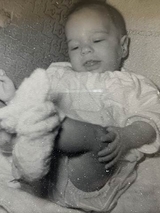Experimental Gene Therapy for Hemophilia B: Bill’s Story
Experimental Gene Therapy for Hemophilia B: Bill’s Story

The blood disorder that 63-year-old Bill was born with, hemophilia B, took its toll. Over the years, the disease caused him to have several serious health issues. He was vaguely aware of work being done on gene therapies for the condition, but “The time frame seemed so far out,” he says. Then a clinical trial opened for an experimental, potentially curative gene therapy that was developed at Children's Hospital of Philadelphia (CHOP). Bill enrolled, and it changed everything.
An inherited gene mutation causes hemophilia B. The mutation severely limits the production of a blood clotting factor called factor IX. The extremely low levels of this clotting factor can cause people to experience prolonged external bleeding. An injury can result in excessive internal bleeding. Sometimes the internal bleeding is spontaneous and leads to chronic joint disease and pain. The bleeding can be life-threatening if it cannot be stopped or if it occurs in a vital region such as the brain.
In Bill’s case, “The first serious bleed I remember was way back,” he says of his childhood in Canada. “I had an incident on my bicycle when the handlebars jabbed me in the abdomen. I ended up with a large blood clot in my abdomen, and it caused quite a bit of concern. I was in the hospital for almost two weeks on a plasma drip.”
When he was a child, plasma administered intravenously was the only treatment option, and not a very effective one. The next development when he was young was long-acting factor IX infusions. “It still involved going to the hospital for several hours to have them administered,” he explains.
“You were always hesitant any time you had a suspected bleed,” he says. “I didn’t want to admit to them. You’d end up in the hospital for six hours.”
A major injury, a yearlong recovery

But he had injuries that required far more care than just a few hours of time. During his first year of high school, he hurt himself while in gym class — he’s not even sure how he did it. But what followed was a major health crisis: “I completely lost the use of my left leg for a year. It atrophied. I was on crutches. Luckily, the nerves slowly healed.”
Such frightening incidents didn’t stop him from being active. He played baseball in his teens. He took up cycling. When he was in his mid-teens, a new treatment option became available: a factor IX product that could be stored and administered at home via injection. To help prevent bleeding episodes, a person with hemophilia regularly administers the factor IX concentrate, often weekly. If an injury occurs, additional injections are needed.
After high school, Bill had an apprenticeship in machining at a trade school and became a machinist. He married and had two daughters. More than 20 years ago, he and several partners went into business for themselves.
Through it all, the disease and the factor IX injections were simply the reality he lived with. Regardless of how familiar he was with managing his hemophilia, he still faced frightening moments. Once, after flying to Florida with his family, he grabbed his golf clubs off the airport’s luggage carousel and hurt his back. “It got more and more sore,” he recalls. “I realized I was bleeding. I had brought only one treatment with me. I didn’t know how to get more factor IX in Florida. It was a scary proposition.” He received enough of the treatment only after his father had it couriered to him in Florida.
A therapy to replace the defective gene
Around 2015, a letter from his hematologist informed him about the gene therapy clinical trial at CHOP. “What I had read about early trials is that they were successful on a very limited basis. At that point, gene therapy had a scary sound to it. I thought, ‘I’ll wait.’” But his brother Jay, who also has hemophilia B, received the same letter and immediately researched the trial. “He and I discussed it. Then I did a lot of my own reading about this trial. Eventually I was quite comfortable with it.”
This potentially curative gene therapy requires a one-time infusion that delivers a functional gene to replace the defective gene. The new gene increases clotting factor activity. Bill received the experimental therapy in March 2017.
“It’s been amazing — just incredible,” he says. He hasn’t needed a single treatment since receiving the gene therapy. But after decades of bleeding, treatments and hospitalizations, it wasn’t easy for Bill to truly comprehend his new reality. “It took three or four years to not get alarmed when I felt a sore muscle and automatically assume it was a bleed.” Not worrying about every pain and sore muscle has been life-changing for Bill: “It’s extremely liberating.”